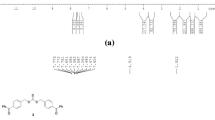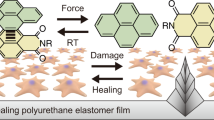Abstract
It is of importance to prepare self-healing materials using reversible covalent bonding within polymers. In this work, we introduced ethyl 4-aminocinnamate (EA) to polyphosphazenes to prepare a novel self-healing elastomer via the reversible photochemical [2+2] cycloaddition. Linear polymer, poly[(n-butylamino) x (ethyl 4-aminocinnamate) y ] phosphazene, was synthesized firstly via the ring-opening polymerization, and then substitution reaction was conducted to introduce EA as side groups. Consequently, the damaged polyphosphazenes were re-healed by being exposed to UV light. Their structures were characterized by 1H-NMR, 31P-NMR, FTIR, and GPC; thermal properties were tested by TGA and DMA. The [2+2] cycloaddition reaction and retro-[2+2] cycloaddition were investigated by UV–vis. The results showed that the broken polyphosphazenes could be self-healed by the UV light irradiation at 365 nm. The damaged polyphasphozene could be re-healed almost completely within about half an hour.







Similar content being viewed by others
References
Murphy EB, Wudl F (2010) The world of smart healable materials. Prog Polym Sci 35:223–251
Hou CY, Duan YR, Zhang QH, Wang HZ, Li YG (2012) Bio-applicable and electroactive near-infrared laser-triggered self-healing hydrogels based on grapheme networks. J Mater Chem 22:14991
Nosonovsky M, Amano R, Lucci JM, Rohatgi PK (2009) Physical chemistry of self-organization and self-healing in metals. Phys Chem Chem Phys 11:9530–9536
Jackson AC, Bartelt JA, Braun PV (2011) Transparent self-healing polymers based on encapsulated plasticizers in a thermoplastic matrix. Adv Funct Mater 21:4705–4711
Hager MD, Greil P, Leyens C, van der Sybrand Z, Ulrich SS (2010) Self-healing materials. Adv Mater 22:5424–5430
Cho SH, White SR, Braun PV (2009) Self-healing polymer coatings. Adv Mater 21:645–649
Caruso MM, Blaiszik BJ, White SR, Sottos NR, Moore JS (2008) Full recovery of fracture toughness using a nontoxic solvent-based self-healing system. Adv Funct Mater 18:1898–1904
Keller MW, White SR, Sottos NR (2009) A self-healing poly(dimethyl siloxane) elastomer. Adv Funct Mater 17:2399–2404
Hansen CJ, Wu W, Toohey KS, Sottos NR, White SR, Lewis JA (2009) Self-healing materials with interpenetrating microvascular networks. Adv Mater 21:4143–4147
Cho SH, Andersson HM, White SR, Sottos NR, Braun PV (2011) Accelerated self-healing via ternary interpenetrating microvascular networks. Adv Funct Mater 21:4320–4326
Xiao DS, Yuan YC, Rong MZ, Zhang MQ (2009) A facile strategy for preparing self-healing polymer composites by incorporation of cationic catalyst-loaded vegetable fibers. Adv Funct Mater 19:2289–2296
Coope TS, Mayer UFJ, Wass DF, Trask RS, Bon IP (2011) Self-healing of an epoxy resin using scandium (iii) triflate as a catalytic curing agent. Adv Funct Mater 21:4624–4631
Jin HC, Mangun LA, Griffi S, Moore JS, Sottos NR, White SR (2014) Thermally stable autonomic healing in epoxy using a dual-microcapsule system. Adv Mater 26:282–287
Barthel MJ, Rudolph T, Teichler A, Paulus RM, Vitz J, Hoeppener S, Hager MD, Schacher FH, Schubert US (2013) Self-healing materials via reversible crosslinking of poly(ethylene oxide)- block- poly(furfuryl glycidyl ether)(PEO- b -PFGE) block copolymer films. Adv Funct Mater 23:4921–4932
Wang C, Liu N, Allen R, Tok JBHY, Wu P, Zhang F, Chen YS, Bao ZN (2013) A rapid and efficient self-healing thermo-reversible elastomer crosslinked with graphene oxide. Adv Mater 25:5785–5790
Pepels M, Filot I, Klumperman B, Goossens H (2013) Self-healing systems based on disulfide–thiol exchange reactions. Polym Chem 4:4955–4965
Zeng F, Han Y, Yan ZC, Liu CY, Chen CF (2013) Supramolecular polymer gel with multi stimuli responsive, self-healing and erasable properties generated by host–guest interactions. Polymer 54:6929–6935
Cheng XJ, Peng C, Zhang DH, Liu SZ, Zhang AQ, Huang H, Lian JS (2013) A facile method for the preparation of thermally remendable cross-linked polyphosphazenes. J Polym Sci A Polym Chem 51:1205–1214
Chung CM, Roh YS, Cho SY, Kim JG (2004) Crack healing in polymeric materials via photochemical [2+2] cycloaddition. Chem Mater 16:3982–3984
Bode S, Bose RK, Matthes S, Ehrhardt M, Seifert A, Schacher FH, Paulus RM, Stumpf S, Sandmann B, Vitz J, Winter A, Hoeppener S, Garcia SJ, Spange S, van der ZS, Hager MD, Schubert US (2013) Self-healing metallopolymers based on cadmium bis(terpyridine) complex containing polymer networks. Polym Chem 4:4966–4973
Bose RK, Kötteritzsch J, Garcia SJ, Hager MD, Schubert US, van der Zwaag S (2014) A rheological and spectroscopic study on the kinetics of self-healing in a single-component Diels-Alder copolymer and its underlying chemical reaction. J Polym Sci A Polym Chem 52:1669–1675
Allcock HR (2003) Chemistry and applications of polyphosphazenes. Wiley, Hoboken
Henke H, Wilfert S, Iturmendi A, Brüggemann O, Teasdale I (2013) Branched polyphosphazenes with controlled dimensions. J Polym Sci A Polym Chem 51:4467–4473
Weikel AL, Krogman NR, Nguyen NQ, Nair LS, Laurencin CT, Allcock HR (2009) Polyphosphazenes that contain dipeptide side groups: synthesis, characterization, and sensitivity to hydrolysis. Macromolecules 42:636–639
Greish YE, Benderb JD, Lakshmi S (2005) Low temperature formation of hydroxyapatite-poly(alkyl oxybenzoate)phosphazene composites for biomedical applications. Biomaterials 26:l–9
Barrett EW, Phelps MVB, Silva RJ, Gaumond RP, Allcock HR (2005) Patterning poly (organophosphazenes) for selective cell adhesion applications. Biomacromolecules 6:1689–1697
Krogman NR, Weikel AL, Kristhart KA, Nukavarapu SP, Deng M, Nair LS, Laurencin CT, Allcock HR (2009) The influence of side group modification in polyphosphazenes on hydrolysis and cell adhesion of blends with PLGA. Biomaterials 30:3035–3041
Allcock HR, Cameron CG (1994) Synthesis and characterization of photo-cross-linkable small-molecule and high-polymeric phosphazenes bearing cinnamate groups. Macromolecules 27:3125–3130
Allcock HR, Cameron CG (1994) Synthesis of photo-cross-linkable chalcone-bearing polyphosphazenes. Macromolecules 27:3131–3135
Hu L, Zhang AQ, Yu Y, Zheng Z, Du SX, Cheng XJ (2014) Synthesis of hybrid crosslinked polyphosphazenes and investigation of their properties. Iran Polym J 23:689–698
Hu L, Zhang AQ, Liu K, Lei S, Ou GX, Cheng XJ (2014) A facile method to prepare composite and porous polyphosphazene membranes and investigation of their properties. RSC Adv 4:35769–35776
Acknowledgements
The authors would like to thank the financial support of NSFC (41240026) and Scientific Research Foundation for the New employees of Southwest University (SWU114110).
Author information
Authors and Affiliations
Corresponding author
Additional information
Xinjian Cheng is the joint first author.
Rights and permissions
About this article
Cite this article
Hu, L., Cheng, X. & Zhang, A. A facile method to prepare UV light-triggered self-healing polyphosphazenes. J Mater Sci 50, 2239–2246 (2015). https://doi.org/10.1007/s10853-014-8786-y
Received:
Accepted:
Published:
Issue Date:
DOI: https://doi.org/10.1007/s10853-014-8786-y




